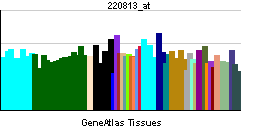Cysteinyl leukotriene receptor 2
| Cysteinyl leukotriene receptor 2 | |||||||||||
|---|---|---|---|---|---|---|---|---|---|---|---|
| Identifiers | |||||||||||
| Symbols | CYSLTR2 ; GPCR; CYSLT2; CYSLT2R; HG57; HPN321; KPG_011; PSEC0146; hGPCR21 | ||||||||||
| External IDs | Template:OMIM5 Template:MGI HomoloGene: 10688 | ||||||||||
| |||||||||||
| RNA expression pattern | |||||||||||
 | |||||||||||
| More reference expression data | |||||||||||
| Orthologs | |||||||||||
| Template:GNF Ortholog box | |||||||||||
| Species | Human | Mouse | |||||||||
| Entrez | n/a | n/a | |||||||||
| Ensembl | n/a | n/a | |||||||||
| UniProt | n/a | n/a | |||||||||
| RefSeq (mRNA) | n/a | n/a | |||||||||
| RefSeq (protein) | n/a | n/a | |||||||||
| Location (UCSC) | n/a | n/a | |||||||||
| PubMed search | n/a | n/a | |||||||||
Cysteinyl leukotriene receptor 2, also known as CYSLTR2, is a human gene.[1]
The cysteinyl leukotrienes LTC4, LTD4, and LTE4 are important mediators of human bronchial asthma. Pharmacologic studies have determined that cysteinyl leukotrienes activate at least 2 receptors, the protein encoded by this gene and CYSLTR1. This encoded receptor is a member of the superfamily of G protein-coupled receptors. It seems to play a major role in endocrine and cardiovascular systems.[1]
See also
References
Further reading
- Van Keer C, Kersters K, De Ley J (1976). "L-Sorbose metabolism in Agrobacterium tumefaciens". Antonie Van Leeuwenhoek. 42 (1–2): 13–24. PMID 1085123.
- Heise CE, O'Dowd BF, Figueroa DJ; et al. (2000). "Characterization of the human cysteinyl leukotriene 2 receptor". J. Biol. Chem. 275 (39): 30531–6. doi:10.1074/jbc.M003490200. PMID 10851239.
- Takasaki J, Kamohara M, Matsumoto M; et al. (2000). "The molecular characterization and tissue distribution of the human cysteinyl leukotriene CysLT(2) receptor". Biochem. Biophys. Res. Commun. 274 (2): 316–22. doi:10.1006/bbrc.2000.3140. PMID 10913337.
- Nothacker HP, Wang Z, Zhu Y; et al. (2001). "Molecular cloning and characterization of a second human cysteinyl leukotriene receptor: discovery of a subtype selective agonist". Mol. Pharmacol. 58 (6): 1601–8. PMID 11093801.
- Mita H, Hasegawa M, Saito H, Akiyama K (2002). "Levels of cysteinyl leukotriene receptor mRNA in human peripheral leucocytes: significantly higher expression of cysteinyl leukotriene receptor 2 mRNA in eosinophils". Clin. Exp. Allergy. 31 (11): 1714–23. PMID 11696047.
- Takeda S, Kadowaki S, Haga T; et al. (2002). "Identification of G protein-coupled receptor genes from the human genome sequence". FEBS Lett. 520 (1–3): 97–101. PMID 12044878.
- Shirasaki H, Kanaizumi E, Watanabe K; et al. (2003). "Expression and localization of the cysteinyl leukotriene 1 receptor in human nasal mucosa". Clin. Exp. Allergy. 32 (7): 1007–12. PMID 12100046.
- Strausberg RL, Feingold EA, Grouse LH; et al. (2003). "Generation and initial analysis of more than 15,000 full-length human and mouse cDNA sequences". Proc. Natl. Acad. Sci. U.S.A. 99 (26): 16899–903. doi:10.1073/pnas.242603899. PMID 12477932.
- Sjöström M, Johansson AS, Schröder O; et al. (2004). "Dominant expression of the CysLT2 receptor accounts for calcium signaling by cysteinyl leukotrienes in human umbilical vein endothelial cells". Arterioscler. Thromb. Vasc. Biol. 23 (8): e37–41. doi:10.1161/01.ATV.0000082689.46538.DF. PMID 12816881.
- Mellor EA, Frank N, Soler D; et al. (2003). "Expression of the type 2 receptor for cysteinyl leukotrienes (CysLT2R) by human mast cells: Functional distinction from CysLT1R". Proc. Natl. Acad. Sci. U.S.A. 100 (20): 11589–93. doi:10.1073/pnas.2034927100. PMID 13679572.
- Thompson MD, Storm van's Gravesande K, Galczenski H; et al. (2004). "A cysteinyl leukotriene 2 receptor variant is associated with atopy in the population of Tristan da Cunha". Pharmacogenetics. 13 (10): 641–9. doi:10.1097/01.fpc.0000054127.14659.42. PMID 14515063.
- Dunham A, Matthews LH, Burton J; et al. (2004). "The DNA sequence and analysis of human chromosome 13". Nature. 428 (6982): 522–8. doi:10.1038/nature02379. PMID 15057823.
- Fukai H, Ogasawara Y, Migita O; et al. (2005). "Association between a polymorphism in cysteinyl leukotriene receptor 2 on chromosome 13q14 and atopic asthma". Pharmacogenetics. 14 (10): 683–90. PMID 15454733.
- Pillai SG, Cousens DJ, Barnes AA; et al. (2005). "A coding polymorphism in the CYSLT2 receptor with reduced affinity to LTD4 is associated with asthma". Pharmacogenetics. 14 (9): 627–33. PMID 15475736.
- Gerhard DS, Wagner L, Feingold EA; et al. (2004). "The status, quality, and expansion of the NIH full-length cDNA project: the Mammalian Gene Collection (MGC)". Genome Res. 14 (10B): 2121–7. doi:10.1101/gr.2596504. PMID 15489334.
- Hui Y, Cheng Y, Smalera I; et al. (2005). "Directed vascular expression of human cysteinyl leukotriene 2 receptor modulates endothelial permeability and systemic blood pressure". Circulation. 110 (21): 3360–6. doi:10.1161/01.CIR.0000147775.50954.AA. PMID 15545522.
- Corrigan C, Mallett K, Ying S; et al. (2005). "Expression of the cysteinyl leukotriene receptors cysLT(1) and cysLT(2) in aspirin-sensitive and aspirin-tolerant chronic rhinosinusitis". J. Allergy Clin. Immunol. 115 (2): 316–22. doi:10.1016/j.jaci.2004.10.051. PMID 15696087.
- Uzonyi B, Lötzer K, Jahn S; et al. (2006). "Cysteinyl leukotriene 2 receptor and protease-activated receptor 1 activate strongly correlated early genes in human endothelial cells". Proc. Natl. Acad. Sci. U.S.A. 103 (16): 6326–31. doi:10.1073/pnas.0601223103. PMID 16606835.
- Woszczek G, Chen LY, Nagineni S; et al. (2007). "IFN-gamma induces cysteinyl leukotriene receptor 2 expression and enhances the responsiveness of human endothelial cells to cysteinyl leukotrienes". J. Immunol. 178 (8): 5262–70. PMID 17404310.
- Klotsman M, York TP, Pillai SG; et al. (2007). "Pharmacogenetics of the 5-lipoxygenase biosynthetic pathway and variable clinical response to montelukast". Pharmacogenet. Genomics. 17 (3): 189–96. doi:10.1097/FPC.0b013e3280120043. PMID 17460547.
| Stub icon | This membrane protein–related article is a stub. You can help Wikipedia by expanding it. |
This article incorporates text from the United States National Library of Medicine, which is in the public domain.